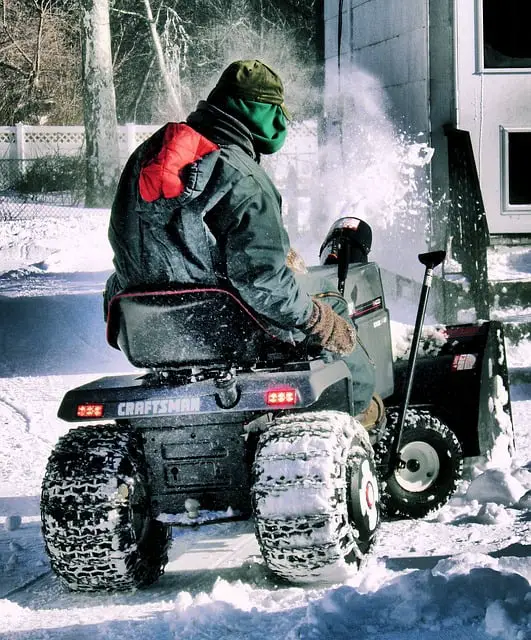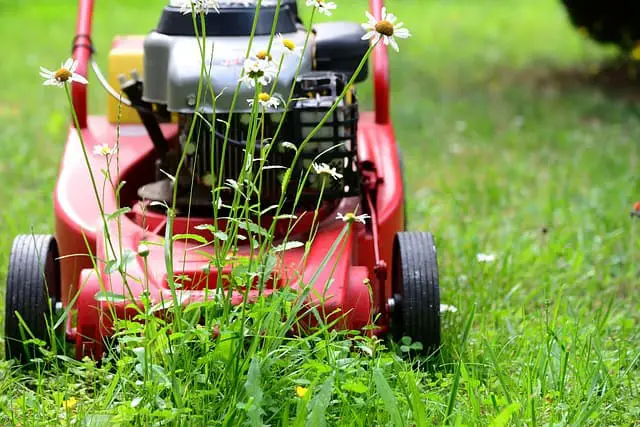The popular notion is you can use WD-40 to prevent snowblowers from clogging with packed snow. The facts say it works. However, if the question is whether WD-40 is a good idea for how it affects snowblowers, you might want to reconsider using it and choose a better alternative.
New snowfall is gorgeous. I love it. I don’t mind working to clear my sidewalks and driveway of recent snowfall. However, I’m not fond of snow building up and clogging my snowblower, preventing it from blowing out snow. My neighbor says WD-40 prevents clogs, but I was skeptical, so I investigated. Read on to learn what I discovered about using WD-40.
Will WD-40 Work To Prevent Snow Buildup In A Snowblower?
WD stands for “water displacement.” Water displacement is simply a process of removing water. For our purpose, WD-40 removes water from snowblower augers, impeller blades, and discharge chutes. If you are curious, 40 comes from the fact that it took 40 times to develop the exact formula which makes it work.
Water removal is made possible by using a surfactant of some type (the exact formula for WD-40 is a secret) that acts as an emulsifier. An emulsifier causes water to mix with the oil in WD-40. The flow, or spray, of WD-40 then washes away the emulsified water mix from the metal.
If applied to a dry surface, the oil in WD-40 prevents water from returning to the metal. It provides a thin protective film or barrier of oil.
In addition, there is some chemical (we don’t know what it is, because they won’t tell us!) that allows WD-40 to firmly and stubbornly adhere to the surface of the metal, providing even more durable and lasting protection from water on metal surfaces.
These qualities enable WD-40 to keep snow and ice from building up on the auger and discharge chute of a snowblower.
Yes, it works.
Is WD-40 Designed To Be An Ice And Snow Repellant?
It is important to remember the solvent properties of WD-40 guided its development. The creator of WD-40 never meant to develop a lubricant or surface protector. He intended to create a liquid for the military in the 50s that would clean Atlas missile parts.
What Other Uses Does WD-40 Have?
WD-40 is also a penetrating oil meant to seep into the rust around frozen nuts and bolts to loosen them and enable their removal. As such, it works very well as a rust remover. In addition, WD-40 works well on removing tar from car finishes or wheel rims.
Common thinking classifies WD-40 as a lubricant, but it is not always the best one. WD-40 has a thin base and may not last as long as heavier oils and grease.
One of the myths about WD-40 says it is an effective treatment for arthritis. While the pain managing properties of WD-40 are unproven, it is proven to cause skin irritation. So, if your snowblower is old, maybe WD-40 will help it move around a bit. But be careful. It may hurt its skin.
Are Other Possible Issues Involved With Use Of WD-40 On A Snowblower?
There are several issues beyond the effectiveness of WD-40. It is a solvent. It contains petroleum distillates.WD-40 evaporates quickly, and it is hygroscopic.
WD-40 As A Solvent
The solvent nature of WD-40 is a two-edged sword. It will remove rust from your auger and help protect it from further rust development.
The downside is while WD-40 can remove rust and tar, it can also dissolve plastic. That doesn’t bode well for any plastic parts on your snowblower it may contact.
WD-40 Contains Petroleum Distillates.
Petroleum distillates are chemicals like mineral spirits, kerosene, Stoddard solvent, and naphtha. I would be careful to avoid any spray-over on the outside of the snowblower. It could cause paint damage. I would watch the paint on the inside of my discharge chute, as well. If it begins to deteriorate by thinning or chipping, I recommend discontinuing the use of WD-40.
WD-40 Evaporates Quickly
Quick evaporation is a peculiar aspect regarding the properties of WD-40. It may not be such an excellent quality regarding long snow removal jobs. If it is necessary to stop and re-apply it, I would question whether or not I want to use it.
WD-40 Is Hygroscopic
Hygroscopic means a substance tends to absorb or attract moisture. It is an aspect of the surfactant emulsifier that mixes water and oil. However, that emulsifier attracts water even after the job and while the snowblower is stored.
Water, oxygen, and metal are the components for oxidation or rust. Do I want to use a product that attracts what could destroy the metal on my snowblower? The possibility it could be harmful is a curiosity that makes me shake my head in doubt.
Are There Alternatives To WD-40?
WD-40 provides alternatives to its original formula. WD-40 Specialist Silicone and WD-40 Specialist White Lithium Grease are better and more expensive lubricants. They are safe to use on plastic and other surfaces, and both are long-lasting. Each one has a wide temperature range, although the Specialist Silicon is superior in this aspect. Both are water-resistant.
The legend in snowblower treatment is PAM. It’s practical, low-cost, and popular. It doesn’t have any solvent properties, so it doesn’t harm paint or plastic. PAM contains lecithin, an emulsifier much like the one in WD-40. However, the blend of three different organic oils in PAM provides superior surface protection and would seem to offset PAM’s hygroscopic facet.
If you want to go even cheaper, you can also use a spray bottle full of vegetable oil. Vegetable oil does not contain lecithin, so that the downside would be it would not emulsify and displace water.
There are commercial products such as DuPont Snow and Ice Repellant, Fluid Film, Other SNO-Jet Snow-Jet Snowblower Spray, and Snow Wax Snow and Ice Repellant Coating. They cost more at $10 to $15 a can, but manufacturers specifically created them to prevent ice and snow from sticking without damaging the surface.


